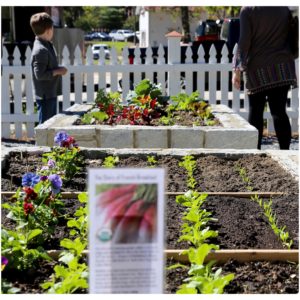I jumped (literally) at the opportunity to do a soil test in bed #23 as soon as Deb fired the starting gun at our beautiful new Norcross Discovery Garden Park. The idea, hardly original, really sprang from a perfect dirt storm of sorts. My mom and step father, master gardeners both who live and dig in Gainesville, sent me a yard (27 CF, also. “a lot”) of Soil3, a commercial organic soil created by a company whose main line of business is sod. They grow grass, yes, but then also make dirt out of their steady supply of trimmings with the help of critters and organic chemistry, of course, then dispense it off the back of a tractor trailer truck like a modern Wells Fargo wagon of black gold. Naturally, I wanted to put this stuff to the (slightly) “acid test.” The other two candidates in my dirty hat trick were a mess of home compost, which I’d been fussing over for several months, and, of course, NDGP “classic”, the good stuff our tax (and SPLOST) dollars bought us to get things growing in the garden.
Back when dinosaurs roamed the earth, I got an A in geometry, so the bed setup came naturally to my advanced mathematical mind: set up three soil types across one axis, then plant three “crops” across the other. (Note, if you can draw an “X” you can do it too!) After three and a half weeks, two thirds of the results are in… our bellies. We have completely harvested our first crop of French breakfast radishes from the compost and Soil3 beds. A second planting is close behind. Beets and onions are following suit, both thriving in the added soils and, well, less so in the “classic.”
The upshot? We were amazed at the difference in the performance of the three soils. Sprouts came up a day earlier in the compost than in the other two beds, possibly due to a slightly higher soil temperature (five degrees or so) as measured over a couple of days. (Note: soil temperature matters—a lot—when sprouting seeds.) Initially, plants in the compost bed noticeably outperformed the other beds, but the Soil3 bed eventually “caught up” as, presumably, initial temperature differences and possibly other conditions equalized. The size of the radishes from the compost and Soil3 beds have been roughly equal, but with a noticeable difference in their shapes, the Soil3 fruit being more cylindrical and the compost fruit more bell- shape. Flavor-wise, no detectable difference between the two “winners,” both equally delicious, especially with a little butter and salt!
Watch this space for updates on beets and onions, both much slower growers than radishes. Who knows, though the NDGP original soil has not kept pace with the other two contenders so far, it may be just the ticket for one or both of the other two plants, both from wholly different plant families, and each with different nutritional & temperature preferences.
I’ll keep you posted… just help us eat all these radishes!

